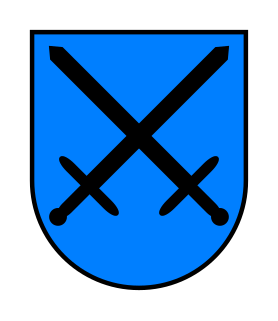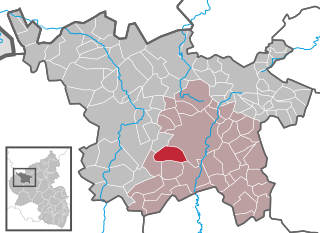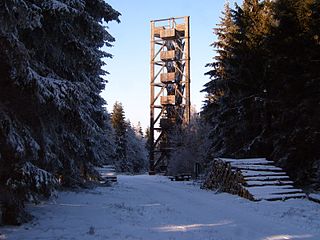The Krawutschke Tower (German:Krawutschketurm) is a 13 metre tall observation tower in the Hürtgenwald municipality in Germany, about one kilometer east of the village center of Bergstein, approximately 10 km south of Düren. The Krawutschke Tower is 400.5 m above sea level, situated on the Burgberg (Engl. castle mountain), which, during World War II, also had the Allied-given name Hill 400 due to its elevation. The Krawutschke Tower has three platforms, one above the other, each separated by three meters.

An observation tower is a structure used to view events from a long distance and to create a full 360 degree range of vision to conduct the long distance observations. They are usually at least 20 metres (66 ft) tall and made from stone, iron, and wood. Many modern towers are also used as TV towers, restaurants, or churches. The towers first appeared in Germany at the end of the 18th century, and their numbers steadily increased, especially after the invention of the lift.

Hürtgenwald is a municipality in the district of Düren in the federal state of North Rhine-Westphalia, Germany. It is located in the Eifel hills, approx. 15 km south-west of Düren. Much of the area is covered by forest.

Germany, officially the Federal Republic of Germany, is a country in Central and Western Europe, lying between the Baltic and North Seas to the north, and the Alps to the south. It borders Denmark to the north, Poland and the Czech Republic to the east, Austria and Switzerland to the south, France to the southwest, and Luxembourg, Belgium and the Netherlands to the west.

On a clear day, one can see Cologne cathedral. Looking eastward, the Nideggen Castle is visible on the other side of the Rur valley. The tower has a panoramic view over the reservoir with the dam at Obermaubach.

Cologne Cathedral is a Catholic cathedral in Cologne, North Rhine-Westphalia, Germany. It is the seat of the Archbishop of Cologne and of the administration of the Archdiocese of Cologne. It is a renowned monument of German Catholicism and Gothic architecture and was declared a World Heritage Site in 1996. It is Germany's most visited landmark, attracting an average of 20,000 people a day, and currently the tallest twin-spired church at 157 m (515 ft) tall.

The ruins of Nideggen Castle are a symbol of the town of Nideggen in Germany and are owned by the county of Düren. The rectangular hill castle was the seat of the powerful counts and dukes of Jülich and had a reputation in the Middle Ages of being impregnable.

The Rur or Roer is a major river that flows through portions of Belgium, Germany and the Netherlands. It is a right (eastern) tributary to the Meuse. About 90 percent of the river's course is in Germany.
In 1911 an observation tower was built on the ruins of the former Berenstein castle, the medieval name Berenstein eventually becoming today's Bergstein. In 1933 a new tower was erected, named Eifelwanderer Franz Krawutschke after the locally famous Eifel Club member, Franz Krawutschke (1862-1940). The tower, which also was being used as a fire lookout tower, was heavily damaged during World War II and then destroyed by a forest fire in 1945. It was rebuilt in 1972, financed by the municipality of Hürtgenwald, the Eifel Club, the district of Düren and the state of North Rhine-Westphalia.

The Eifel Club is one of the largest rambling clubs in Germany with a membership of 28.000. Its purpose is the "maintenance of local customs, the protection and care of monuments to which it is particularly committed".

A fire lookout tower, fire tower or lookout tower, provides housing and protection for a person known as a "fire lookout" whose duty it is to search for wildfires in the wilderness. The fire lookout tower is a small building, usually located on the summit of a mountain or other high vantage point, in order to maximize the viewing distance and range, known as view shed. From this vantage point the fire lookout can see smoke that may develop, determine the location by using a device known as an Osborne Fire Finder, and call fire suppression personnel to the fire. Lookouts also report weather changes and plot the location of lightning strikes during storms. The location of the strike is monitored for a period of days after in case of ignition.

North Rhine-Westphalia is a state of Germany.
From July 2005 to November 2006 the tower had to be closed for safety reasons. After renovation of a substantial part of the supporting wooden construction (costs about € 65,000), the tower is open to the public again.














